If you’ve ever been to a farm, you may have seen chickens. The most common breeds of chicken are the White Leghorns and Rhode Island Reds. However, they aren’t all that popular with chicken enthusiasts because there are so many other breeds out there! Here is our list of 10 top blue chicken breeds!
10 Blue Chicken Breeds
This is a list of the 10 most popular blue chicken breeds recognized by the American Poultry Association.
Blue Andalusian Chicken

This breed was admitted to the APA in 1874. This is a very good-looking bird.
The Blue Andalusian breed can reach up to 5.5 for hens to 7 pounds in weight for the roosters. Bantams weigh around 28 oz.
They are a decent egg layers with a hen laying about 160 eggs per year!
They are also very friendly and love human contact which makes them great pets. This bird was bred to be beautiful with its light blue plumage so they need a lot of care, especially if you want to show them.
Do You Want Big Beautiful Eggs?
Then you must check this ORGANIC & NON-GMO feed. Our hens lay jumbo eggs now and they love this feed! You can check it right here on Amazon.
Blue Orpington Chicken
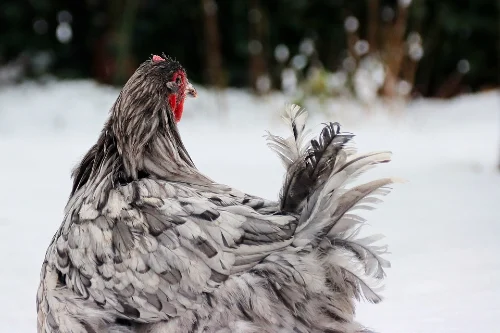
The Blue Orpingtons were admitted to the APA in 1923. They are large chicken breed that can weigh up to 8 – 10 pounds.
Orpington hens lay around 190 brown eggs each year!
They are an excellent choice of backyard chickens because of their suitability for both meat and eggs.
This breed has three other color variations, including black, white and buff. They are friendly birds that like to be petted.
Blue Plymouth Rock
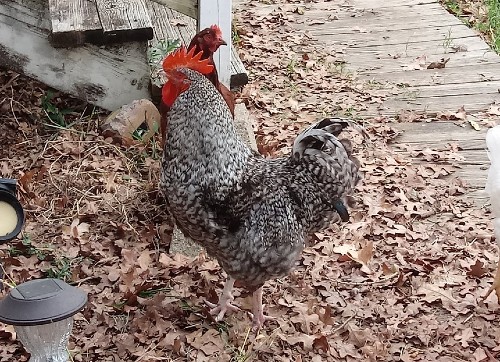
The Blue chicken variety of the Plymouth Rock was admitted to the APA in 1920. This breed can reach up to 6 -7 pounds for hens, roosters weigh about 8 pounds!
These chickens have a high egg production rate, laying around 200 brown eggs each year. They are also good pets because they are very tame and friendly!
The Plymouth Rock is an all American breed, but it’s not the only blue chicken breed originating from the US.
Wyandotte Chicken
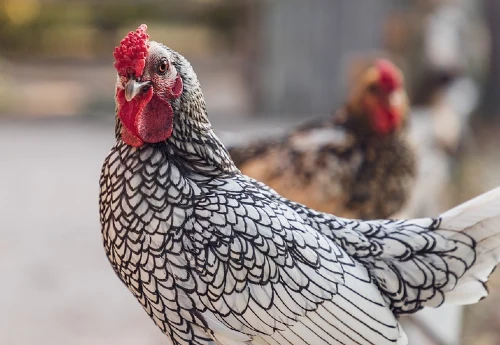
The Blue Wyandottes were admitted to the APA in 1977. They are a medium-sized to large breed of chicken that can weigh up to 6.5 pounds for hens, roosters weigh more at about 8 – 9 pounds!
These chickens are very popular with backyard farmers because they produce decent numbers of brown eggs yearly. Each hen lays approximately 180 to 200 eggs a year.
They are also friendly and make good pets!
Blue Old English Game

The blue variety of this chicken breed was admitted to the APA in 1976. It is a medium sized blue breed of chicken that can reach up to 4 to 5 pounds, and 22 – 24 oz for the its bantam version.
They are not very friendly and shouldn’t be kept with other birds, unless there is a lot of space.
They are a terrible breed for egg production as a hen can only give you 40 eggs in one year.
The Old English Game breed was bred for fighting due to their roosters with aggressive nature and toughness. Because of this reason it can be used as a “guard dog” on farms!
Blue Cochin Chicken
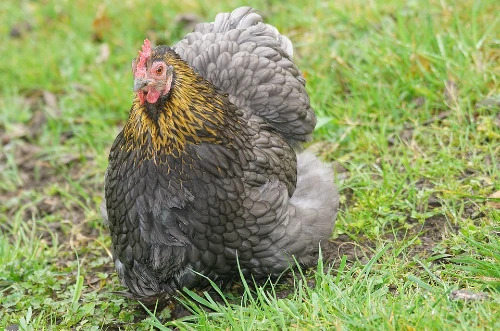
This blue chicken breed was admitted to the APA in 1977. The roosters of this breed can reach up to 10 – 11 pounds, although the hens are a little bit smaller and can reach up to only 8.5 pounds.
Hens on average lay around 140 eggs per year.
The Cochin has a pretty appearance with its feathers on their legs, so there is no denying that they are some of the most beautiful chicken breeds in existence.
Being one of the most cold-hardy chicken breeds, they also make great pets because of their friendliness and their calm nature.
Silkie Bearded Blue Chicken
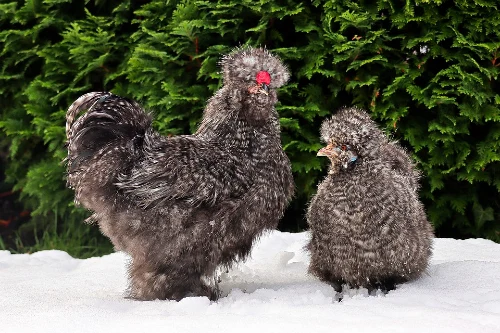
This blue chicken breed was admitted to the APA in 1996.
The roosters weigh around 6 pounds and hens can reach up to 4 pounds.
Hens can produce at most 100 eggs per year.
These birds have soft feathers which require a lot of care, but that doesn’t matter since these birds are awesome. Silkie chickens make good pets and get along with other chickens.
Jersey Giant Chicken
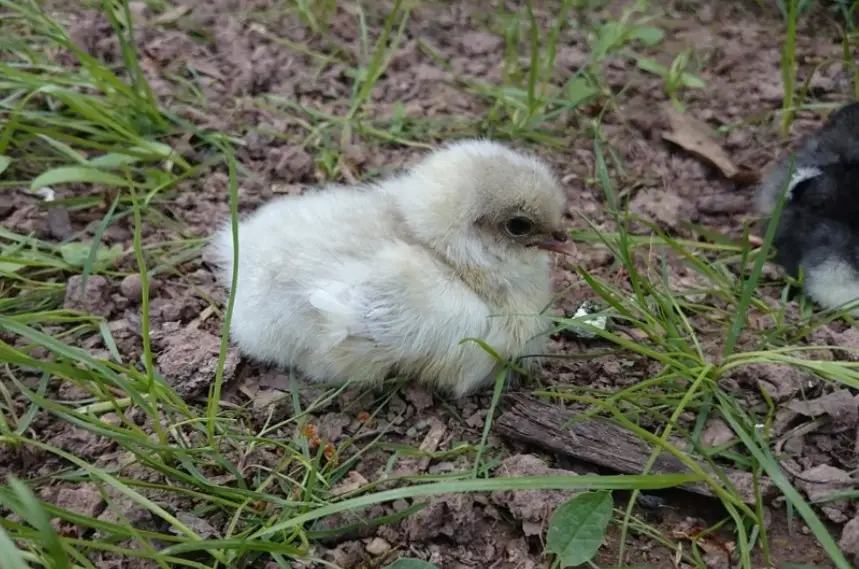
Developed in New Jersey, this is the largest of all blue chicken breeds around.
The Blue Jersey Giant was admitted to the APA in 2002. This breed can have large sized roosters that can weight up to 13 pounds!
Hens are smaller, around 9 – 10 pounds.
They lay around 180 brown eggs almost every year! This bird is a popular choice for all sorts of reasons, including its excellent egg laying abilities and meat production.
Sumatra

Of all blue chicken breeds on our list, the Blue Sumatra chicken was only recently admitted to the APA in 2003, so they are very rare chicken breed.
They have medium sized roosters that can weight up to 5 pounds and hens around 4 pounds or so.
Hens lay about 100 eggs per year.
They are very aggressive breed of chicken, not like many other blue chickens on this list.
Developed initially for fighting, they come from Indonesia but were brought over to America in the 1800s. Its first variety was admitted to APA in 1883.
Blue Ameraucana Chicken
The Ameraucana or “Easter Egger” is a breed of chicken originating from America.
This blue chicken variety was admitted to the APA in 1984.
The Ameraucana roosters can weigh up to 6.5 pounds, while the hens are much smaller and can reach only 4.5-5 pounds!
The Ameraucana hens are amazing egg layers of blue (in various shades) eggs. They generally produce around 200-300 eggs a year. Amazing, isn’t it?
This bird makes for a great pet because it’s friendly, even though it has its temperament sometimes.
Final Thoughts on Blue Chicken Breeds
If you’re looking for a good pet, a good egg layer, or just want to have blue eggs in your backyard, we’ve got 10 of the most popular blue chicken breeds for you. All recognized by the APA.
Whether they are gentle and friendly (like the Plymouth Rock) or aggressive fighters from Indonesia (such as Sumatra), there is an option out there for everyone’s taste.
These chickens can vary in size and egg production rates so it may be worth experimenting with different breeds until you find one that suits your needs!

